Experimental Analysis of Ultra-High-Frequency Signal Propagation Paths in Power Transformers
Abstract
:1. Introduction
2. Experimental Setup
2.1. Transformer A
2.2. Transformer B
3. Simulation Setup
4. Results
4.1. Basic Signal Analysis
4.2. Distance-Dependent Signal Attenuation
4.3. Line-of-Sight Distance vs. Propagation Distance
4.4. Simulation Results
5. Conclusions
6. Outlook
Author Contributions
Funding
Institutional Review Board Statement
Informed Consent Statement
Data Availability Statement
Conflicts of Interest
References
- Hussain, M.R.; Refaat, S.S.; Abu-Rub, H. Overview and Partial Discharge Analysis of Power Transformers: A Literature Review. IEEE Access 2021, 9, 64587–64605. [Google Scholar] [CrossRef]
- Dukanac, D. Application of UHF method for partial discharge source location in power transformers. IEEE Trans. Dielectr. Electr. Insul. 2018, 25, 2266–2278. [Google Scholar] [CrossRef]
- Judd, M.D.; Yang, L.; Hunter, I. Partial discharge monitoring of power transformers using UHF sensors. Part I: Sensors and signal interpretation. IEEE Electr. Insul. Mag. 2005, 21, 5–14. [Google Scholar] [CrossRef]
- Jahangir, H.; Akbari, A.; Azirani, M.A.; Werle, P.; Szczechowski, J. Turret-Electrode Antenna for UHF PD Measurement in Power Transformers—Part I: Introduction and Design. IEEE Trans. Dielectr. Electr. Insul. 2020, 27, 2113–2121. [Google Scholar] [CrossRef]
- Chai, H.; Phung, B.T.; Zhang, D. Development of UHF Sensors for Partial Discharge Detection in Power Transformer. In Proceedings of the 2018 Condition Monitoring and Diagnosis (CMD), Perth, WA, USA, 23–26 September 2018; IEEE: Piscataway, NJ, USA, 2018; pp. 1–5, ISBN 978-1-5386-4126-2. [Google Scholar]
- Cruz, J.d.N.; Serres, A.J.R.; de Oliveira, A.C.; Xavier, G.V.R.; de Albuquerque, C.C.R.; da Costa, E.G.; Freire, R.C.S. Bio-inspired Printed Monopole Antenna Applied to Partial Discharge Detection. Sensors 2019, 19, 628. [Google Scholar] [CrossRef] [PubMed] [Green Version]
- Zhou, X.; Wu, X.; Ding, P.; Li, X.; He, N.; Zhang, G.; Zhang, X. Research on Transformer Partial Discharge UHF Pattern Recognition Based on Cnn-lstm. Energies 2020, 13, 61. [Google Scholar] [CrossRef] [Green Version]
- Do, T.-D.; Tuyet-Doan, V.-N.; Cho, Y.-S.; Sun, J.-H.; Kim, Y.-H. Convolutional-Neural-Network-Based Partial Discharge Diagnosis for Power Transformer Using UHF Sensor. IEEE Access 2020, 8, 207377–207388. [Google Scholar] [CrossRef]
- Xue, N.; Yang, J.; Shen, D.; Xu, P.; Yang, K.; Zhuo, Z.; Zhang, L.; Zhang, J. The Location of Partial Discharge Sources Inside Power Transformers Based on TDOA Database with UHF Sensors. IEEE Access 2019, 7, 146732–146744. [Google Scholar] [CrossRef]
- Nobrega, L.; Costa, E.; Serres, A.; Xavier, G.; Aquino, M. UHF Partial Discharge Location in Power Transformers via Solution of the Maxwell Equations in a Computational Environment. Sensors 2019, 19, 3435. [Google Scholar] [CrossRef] [PubMed] [Green Version]
- Mirzaei, H.; Akbari, A.; Gockenbach, E.; Miralikhani, K. Advancing new techniques for UHF PDdetection and localization in the power transformers in the factory tests. IEEE Trans. Dielectr. Electr. Insul. 2015, 22, 448–455. [Google Scholar] [CrossRef]
- Siegel, M.; Coenen, S.; Beltle, M.; Tenbohlen, S.; Weber, M.; Fehlmann, P.; Hoek, S.M.; Kempf, U.; Schwarz, R.; Linn, T.; et al. Calibration Proposal for UHF Partial Discharge Measurements at Power Transformers. Energies 2019, 12, 3058. [Google Scholar] [CrossRef] [Green Version]
- Jahangir, H.; Akbari, A.; Werle, P.; Szczechowski, J. Possibility of PD calibration on power transformers using UHF probes. IEEE Trans. Dielectr. Electr. Insul. 2017, 24, 2968–2976. [Google Scholar] [CrossRef]
- Mirzaei, H.R.; Akbari, A.; Zanjani, M.; Miralikhani, K.; Gockenbach, E.; Borsi, H. Investigating suitable positions in power transformers for installing UHF antennas for partial discharge localization. In Proceedings of the International Conference on Condition Monitoring and Diagnosis (CMD), Bali, Indonesia, 23–27 September 2012; IEEE: Piscataway, NJ, USA, 2012; pp. 625–628, ISBN 978-1-4673-1020-8. [Google Scholar]
- Coenen, S.; Tenbohlen, S. Location of PD sources in power transformers by UHF and acoustic measurements. IEEE Trans. Dielect. Electr. Insul. 2012, 19, 1934–1940. [Google Scholar] [CrossRef]
- Ishak, A.M.; Judd, M.D.; Siew, W.H. A study of UHF partial discharge signal propagation in power transformers using FDTD modelling. In Proceedings of the 45th International Universities’ Power Engineering Conference, UPEC 2010, Cardiff, UK, 31 August–3 September 2010; Institution of Engineering and Technology: London, UK, 2011; pp. 1–5, ISBN 978-1-4244-7667-1. [Google Scholar]
- Nobrega, L.A.; Xavier, G.V.; Serres, A.J. Investigating reflections and refractions effects in the UHF Location of partial discharges in power transformers using time domain simulation. In Proceedings of the 2018 Simposio Brasileiro de Sistemas Eletricos (SBSE), Niteroi, Brazil, 12–16 May 2018. [Google Scholar]
- Du, J.; Chen, W.; Cui, L.; Zhang, Z.; Tenbohlen, S. Investigation on the propagation characteristics of PD-induced electromagnetic waves in an actual 110 kV power transformer and its simulation results. IEEE Trans. Dielect. Electr. Insul. 2018, 25, 1941–1948. [Google Scholar] [CrossRef]
- Beura, C.P.; Beltle, M.; Tenbohlen, S.; Siegel, M. Quantitative Analysis of the Sensitivity of UHF Sensor Positions on a 420 kV Power Transformer Based on Electromagnetic Simulation. Energies 2020, 13, 3. [Google Scholar] [CrossRef] [Green Version]
- BSS Hochspannungstechnik GmbH. HFIG-600 VHF/UHF High Power Impulse Generator. Available online: https://www.bss-hochspannungstechnik.de/pdf/Datasheet%20HFIG-600.pdf (accessed on 20 February 2022).
- Beura, C.P.; Beltle, M.; Tenbohlen, S. Positioning of UHF PD Sensors on Power Transformers Based on the Attenuation of UHF Signals. IEEE Trans. Power Deliv. 2019, 34, 1520–1529. [Google Scholar] [CrossRef]
- Tenbohlen, S.; Coenen, S.; Siegel, M.; Linn, T.; Markalous, S.; Mraz, P.; Beltle, M.; Naderian, A.; Schmidt, V.; Fuhr, J.; et al. Improvements to PD measurements for factory and site acceptance tests of power transformers. In Cigre Technical Brochure 861; Cigre: Paris, France, 2022. [Google Scholar]
- Beura, C.P.; Beltle, M.; Tenbohlen, S. Attenuation of UHF Signals in a 420 kV Power Transformer Based on Experiments and Simulation. In Proceedings of the 21st International Symposium on High Voltage Engineering, Budapest, Hungary, 26–30 August 2019; Németh, B., Ed.; Springer International Publishing: Cham, Switzerland, 2020; pp. 1276–1285, ISBN 978-3-030-31679-2. [Google Scholar]
- Zanjani, M.; Akbari, A.; Mirzaei, H.R.; Shirdel, N.; Gockenbach, E.; Borsi, H. Investigating partial discharge UHF electromagnetic waves propagation in transformers using FDTD technique and 3D simulation. In Proceedings of the IEEE International Conference on Condition Monitoring and Diagnosis (CMD 2012), Bali, Indonesia, 23–27 September 2012; IEEE: Piscataway, NJ, USA, 2012; pp. 497–500, ISBN 978-1-4673-1019-2. [Google Scholar]
- Yang, L.; Judd, M.D.; Costa, G. Simulating propagation of UHF signals for PD monitoring in transformers using the finite difference time domain technique. In Proceedings of the 17th Annual Meeting of the IEEE Lasers and Electro-Optics Society, LEOS 2004, Boulder, CO, USA, 17–20 October 2004; IEEE: Piscataway, NJ, USA, 2004; pp. 410–413, ISBN 0-7803-8584-5. [Google Scholar]
- Giglia, G.; Ala, G.; Castiglia, V.; Imburgia, A.; Miceli, R.; Rizzo, G.; Romano, P.; Schettino, G.; Viola, F. Electromagnetic Full-Wave Simulation of Partial Discharge Detection in High Voltage AC Cables. In Proceedings of the 2019 IEEE 5th International forum on Research and Technology for Society and Industry (RTSI), Florence, Italy, 9–12 September 2019; IEEE: Piscataway, NJ, USA, 2019; pp. 166–171, ISBN 978-1-7281-3815-2. [Google Scholar]
- Akbarzadeh, A.R.; Shen, Z. On the Gap Source Model for Monopole Antennas. IEEE Antennas Wirel. Propag. Lett. 2008, 7, 115–118. [Google Scholar] [CrossRef]
- Umemoto, T.; Tenbohlen, S. Novel Simulation Technique of Electromagnetic Wave Propagation in the Ultra High Frequency Range within Power Transformers. Sensors 2018, 18, 4236. [Google Scholar] [CrossRef] [PubMed] [Green Version]
- Beura, C.P.; Beltle, M.; Tenbohlen, S. Study of the Influence of Winding and Sensor Design on Ultra-High Frequency Partial Discharge Signals in Power Transformers. Sensors 2020, 20, 5113. [Google Scholar] [CrossRef] [PubMed]
- Balanis, C.A. Modern Antenna Handbook; Wiley-Blackwell: Oxford, UK, 2008; ISBN 978-0-470-03634-1. [Google Scholar]
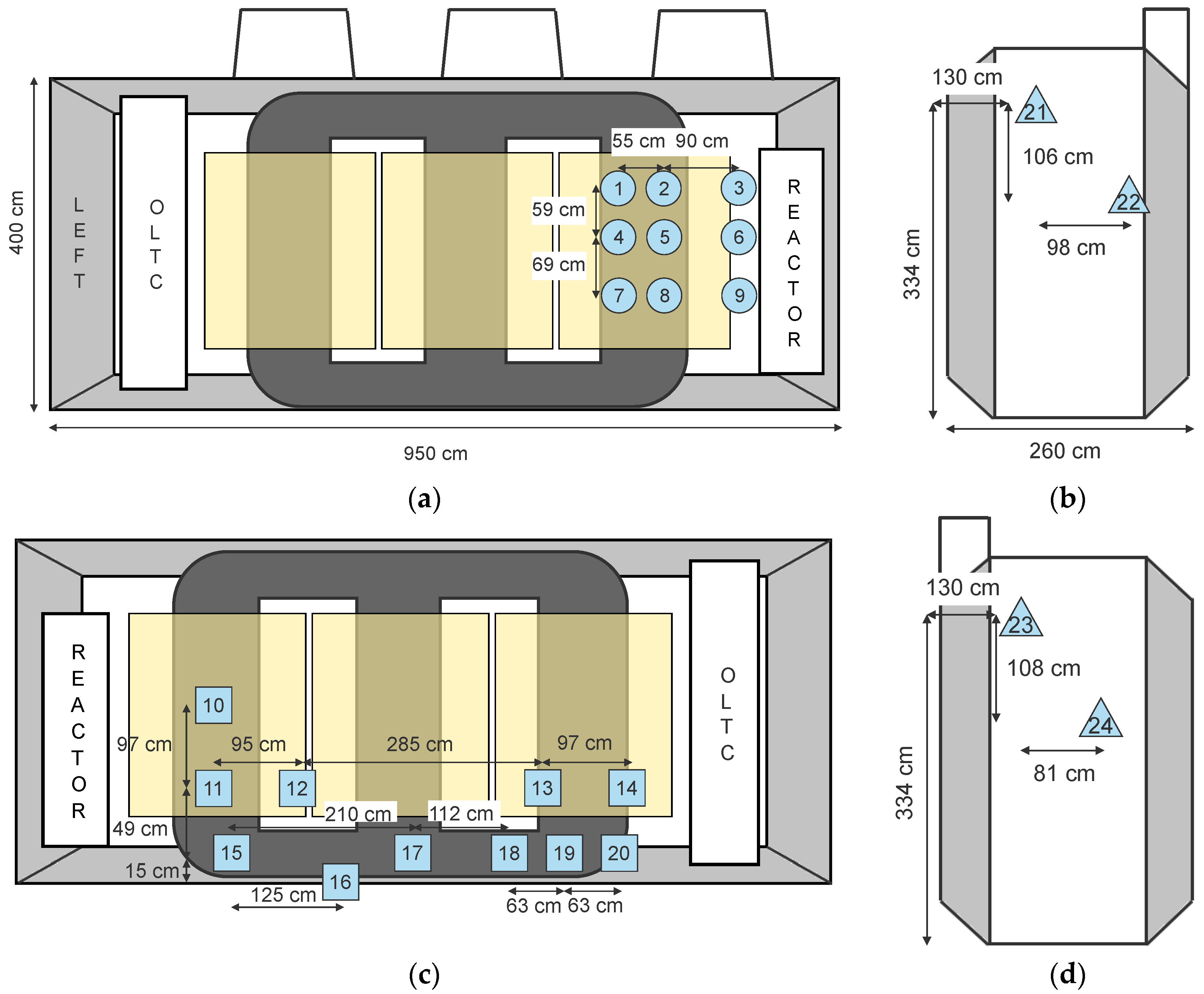


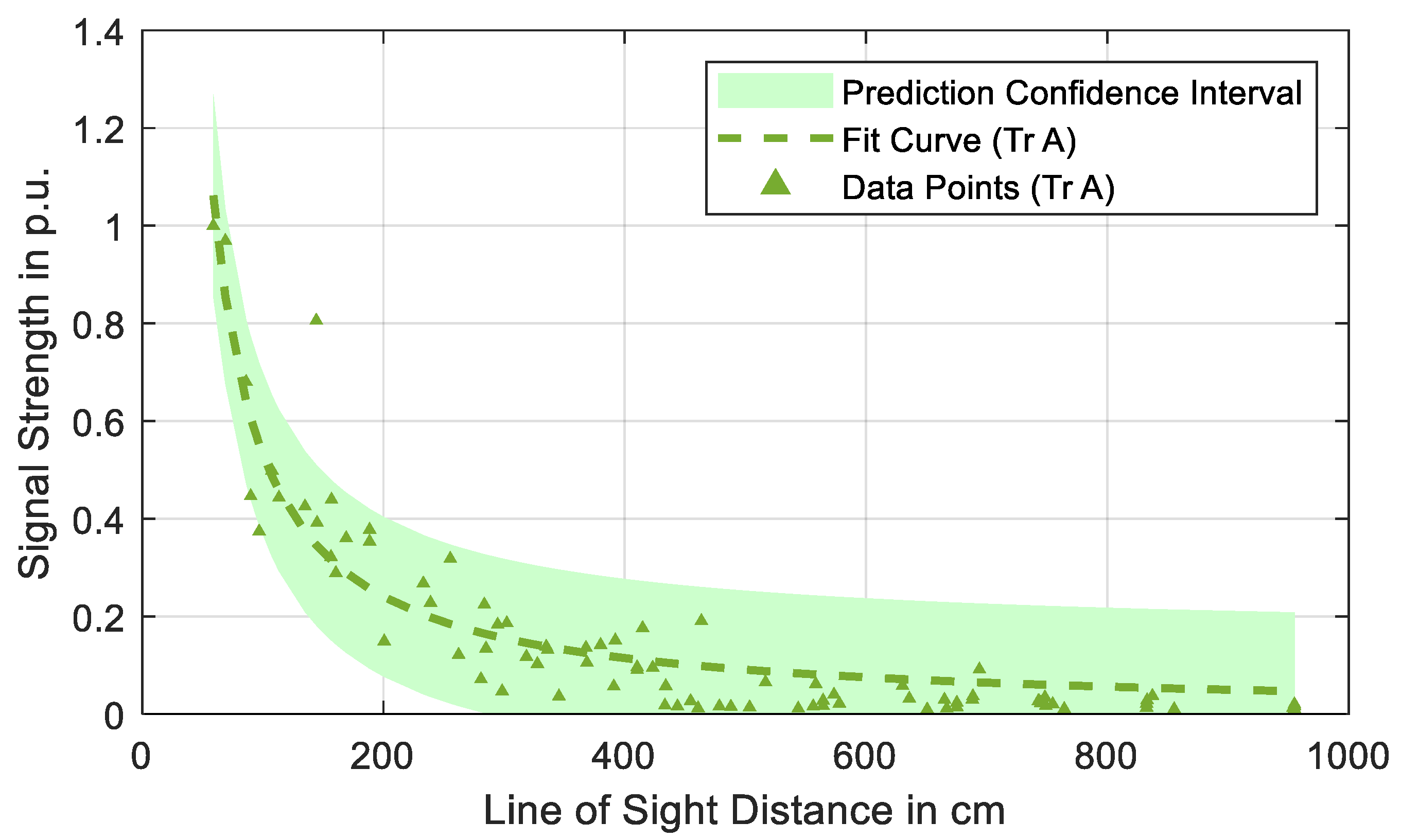

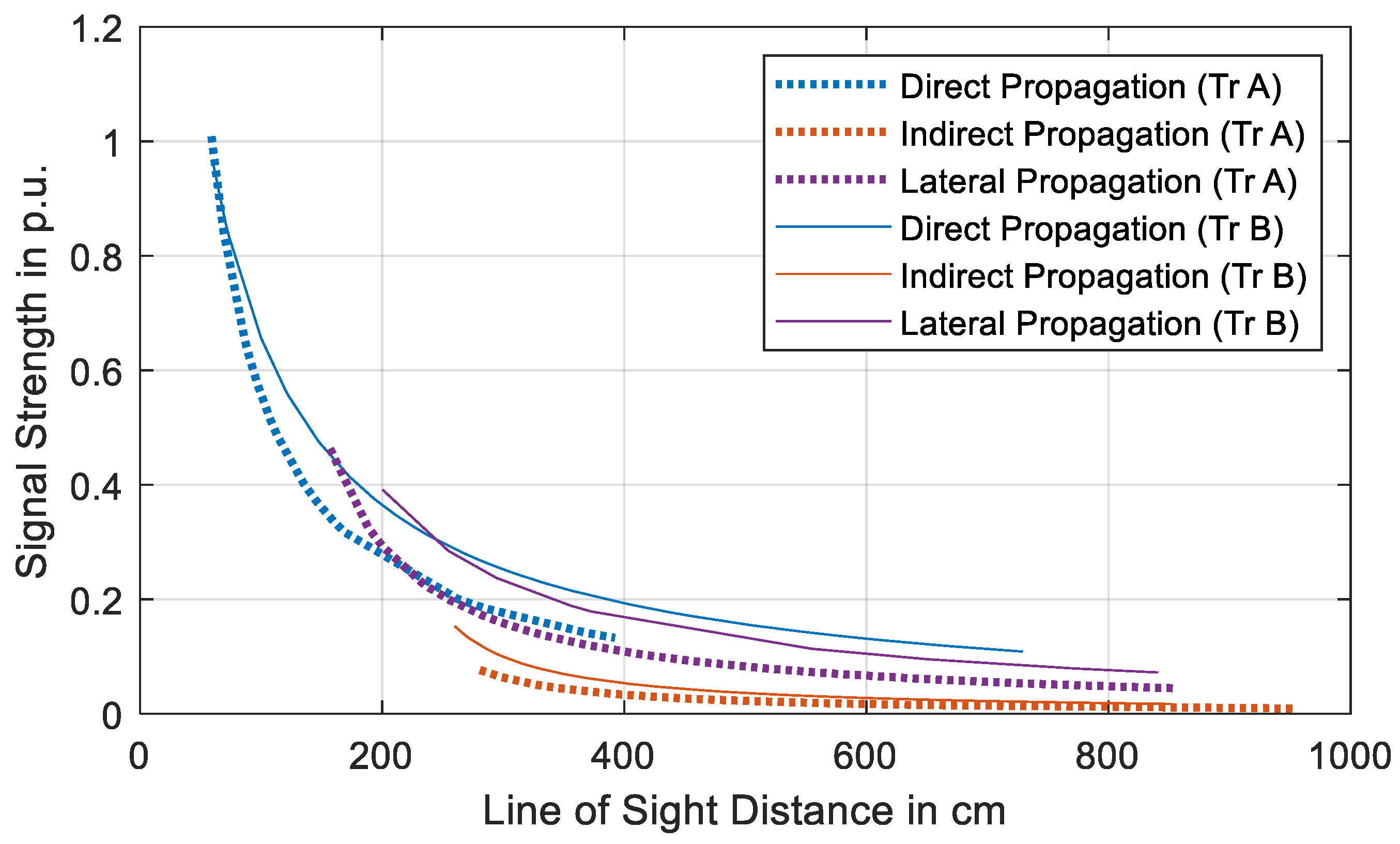
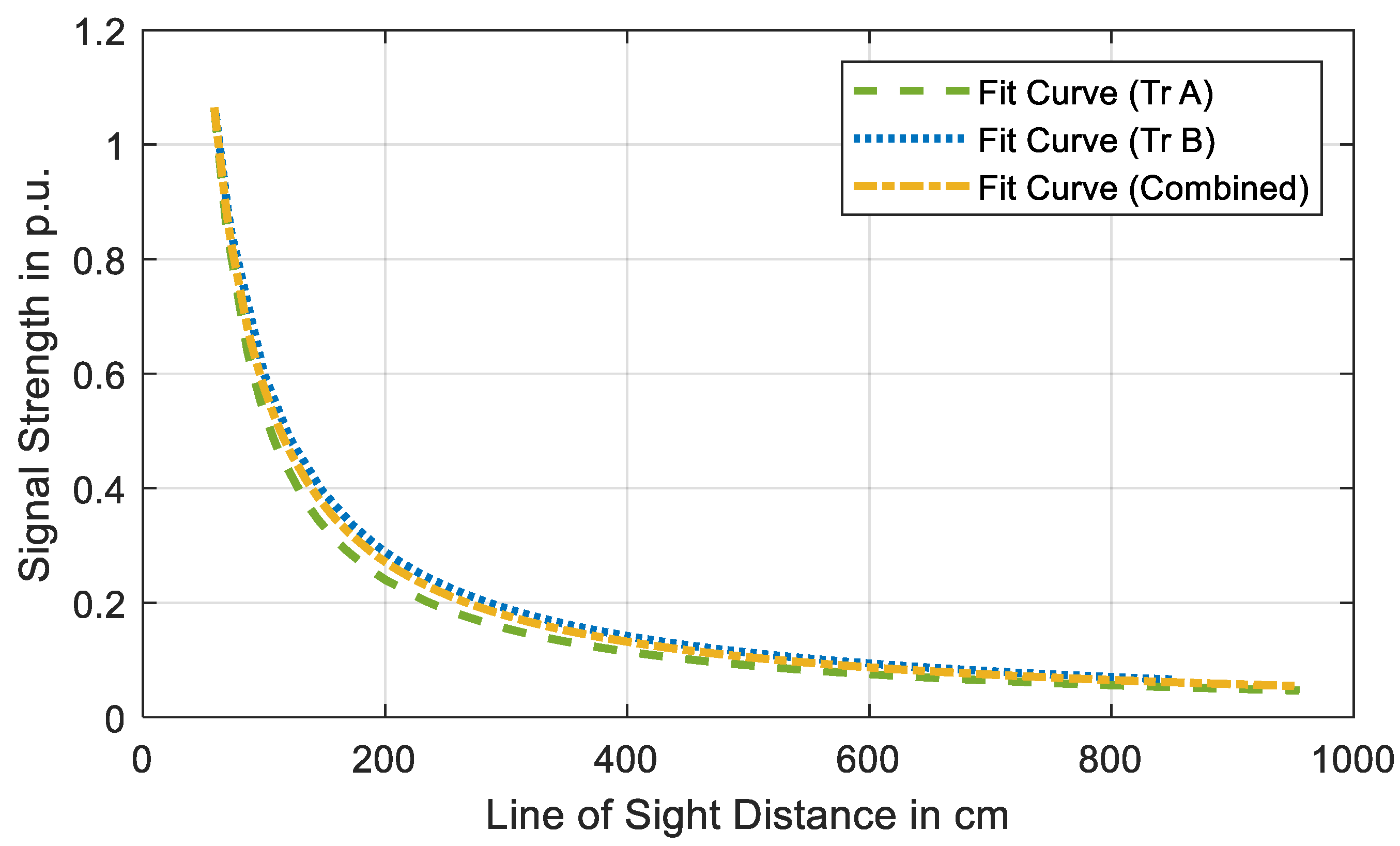



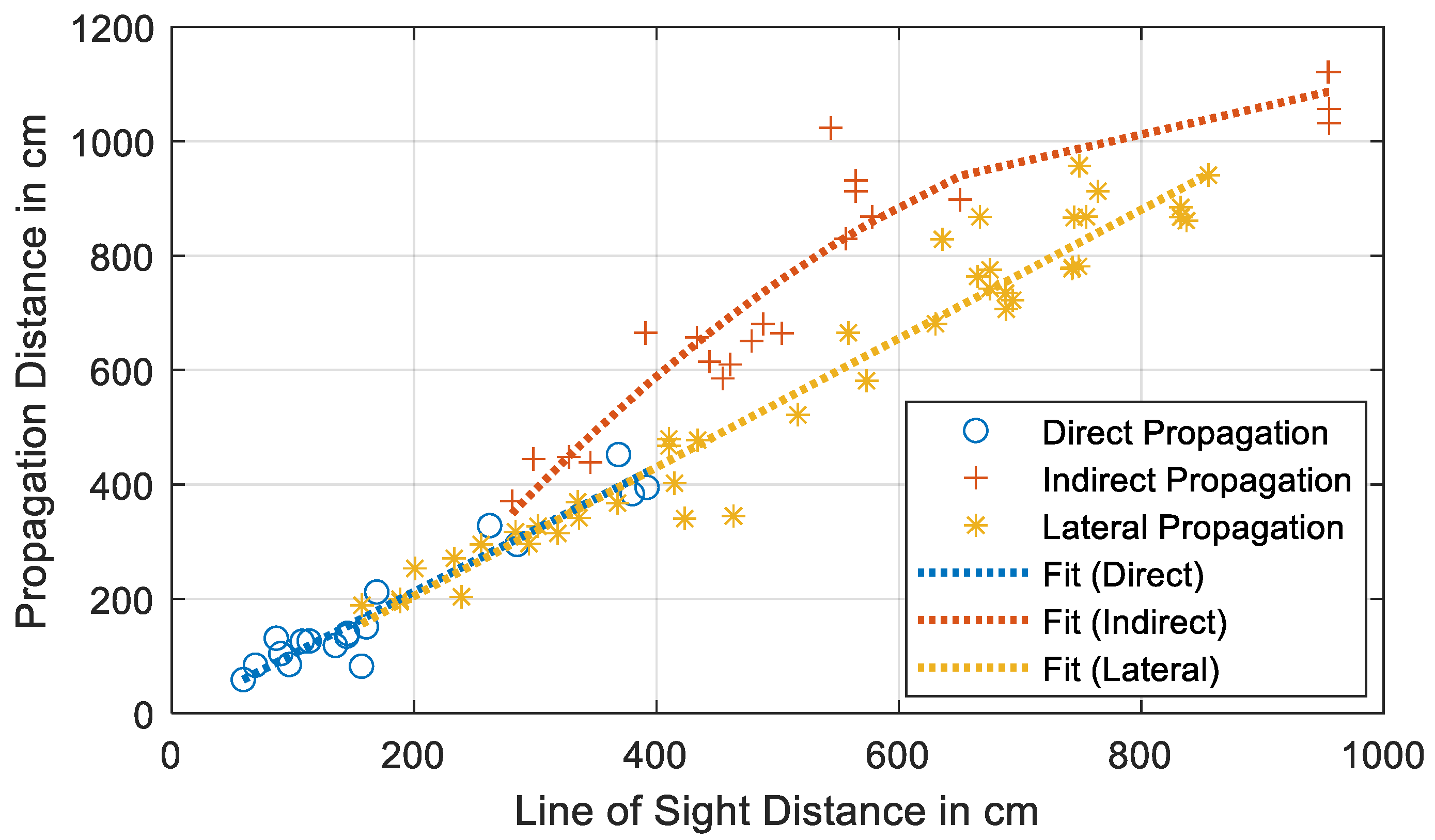
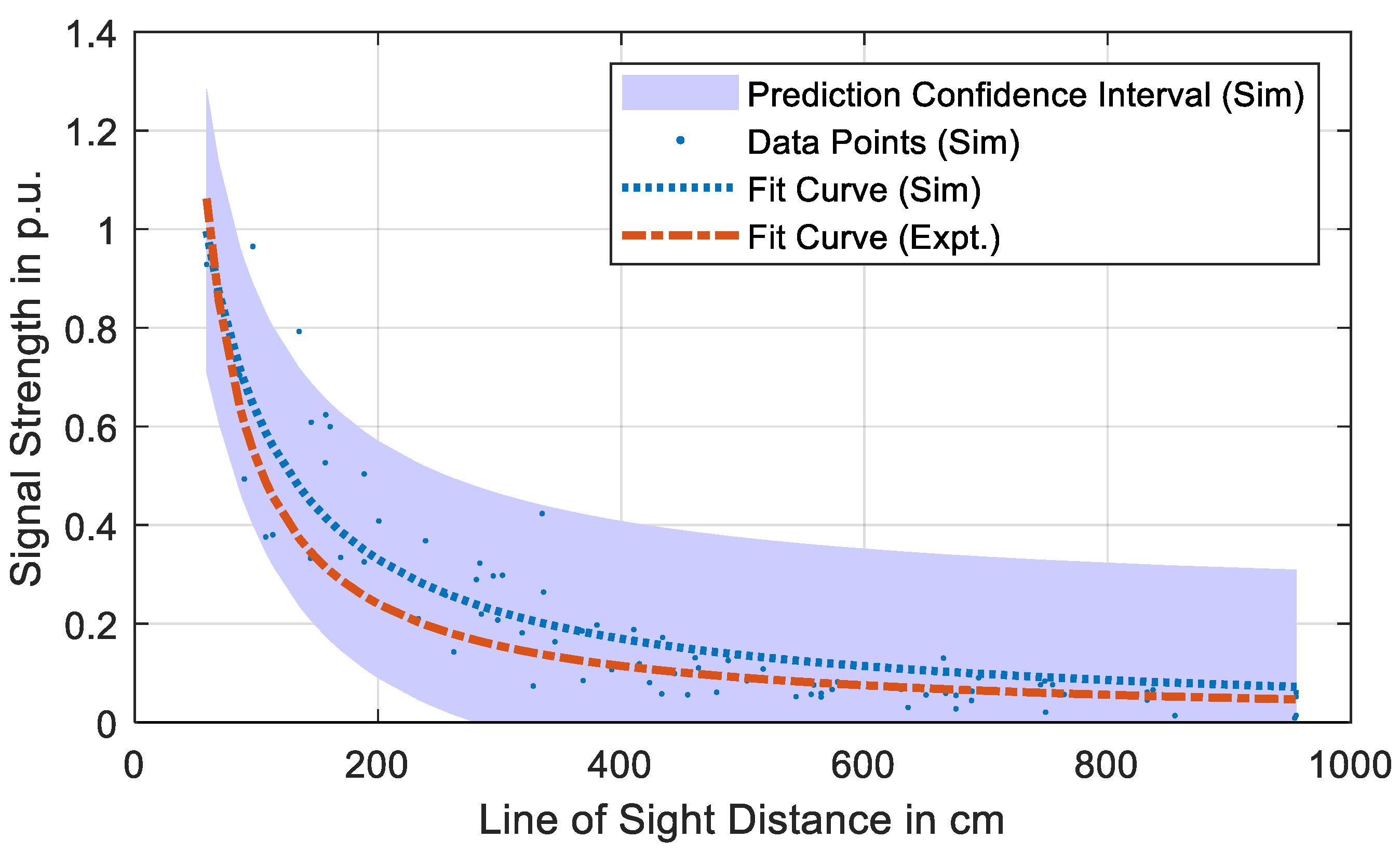
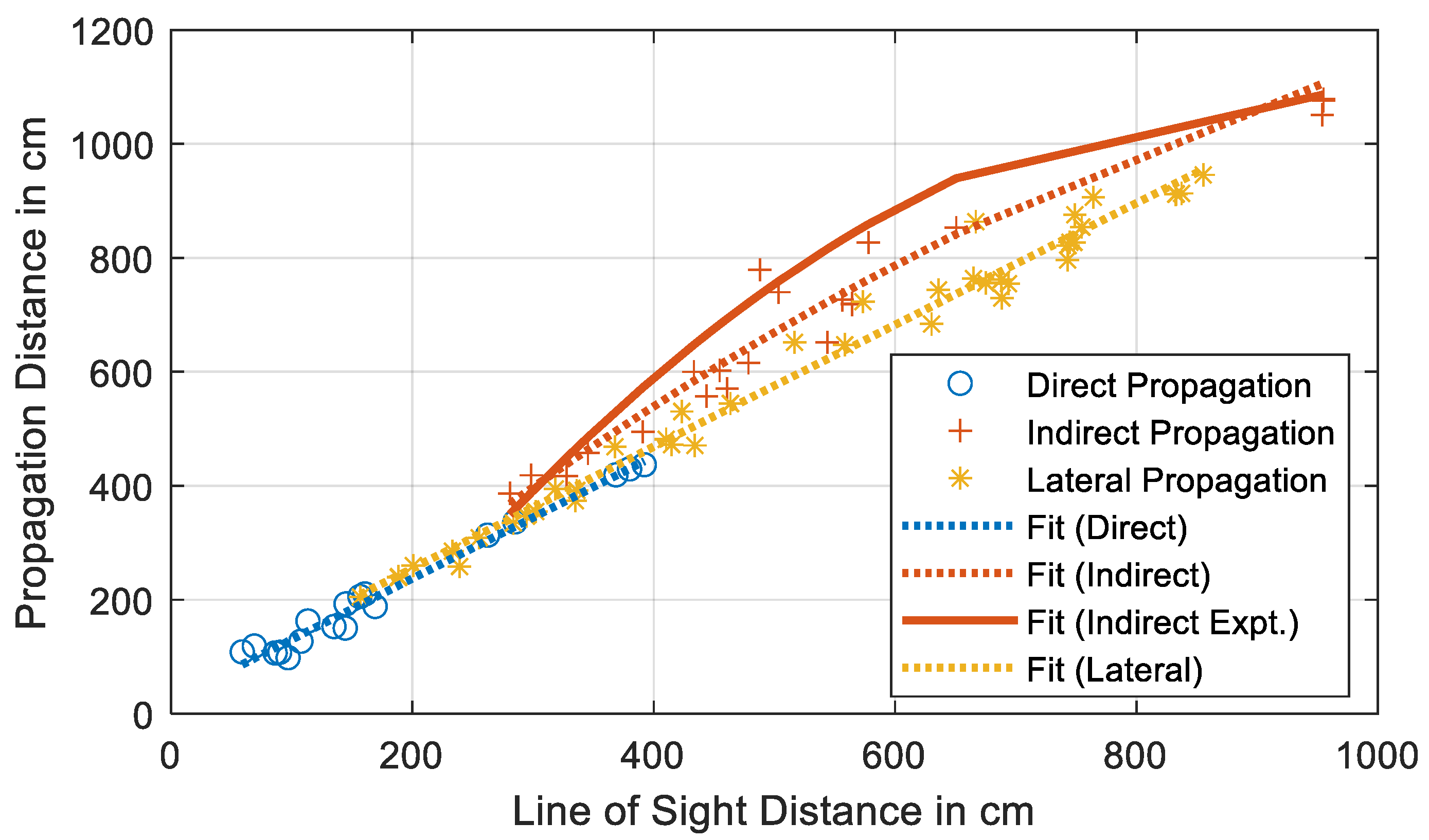
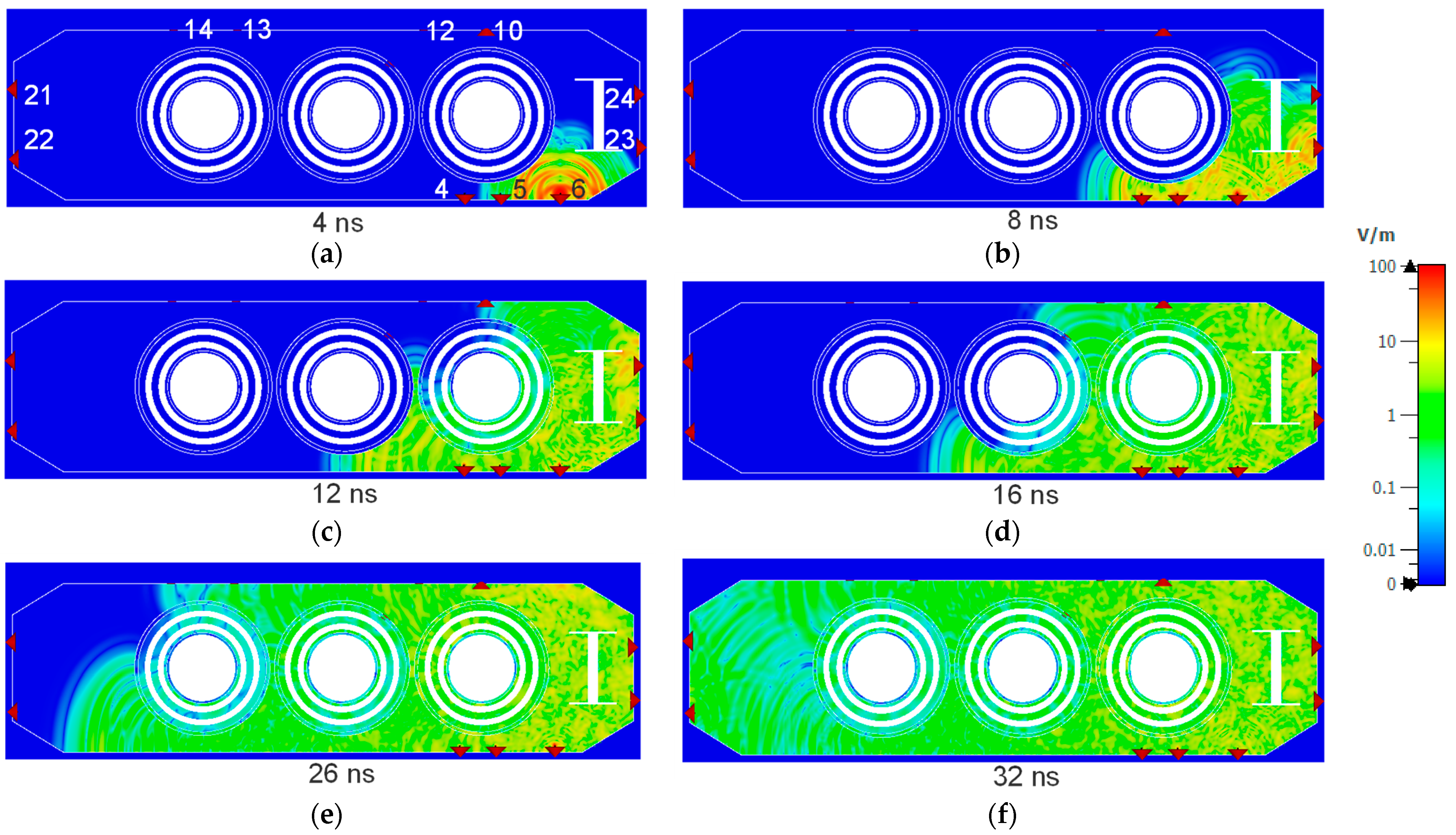
| Parameters | Transformer A | Transformer B |
|---|---|---|
| Tank dimensions (cm × cm × cm) | 900 × 400 × 260 | 900 × 400 × 260 |
| Maximum attenuation (dB) | −40.5 | −37 |
| LoS distance at maximum attenuation (cm) | 650 | 692 |
| Goodness of fit (R2) | 0.8515 | 0.7709 |
Publisher’s Note: MDPI stays neutral with regard to jurisdictional claims in published maps and institutional affiliations. |
© 2022 by the authors. Licensee MDPI, Basel, Switzerland. This article is an open access article distributed under the terms and conditions of the Creative Commons Attribution (CC BY) license (https://creativecommons.org/licenses/by/4.0/).
Share and Cite
Beura, C.P.; Beltle, M.; Wenger, P.; Tenbohlen, S. Experimental Analysis of Ultra-High-Frequency Signal Propagation Paths in Power Transformers. Energies 2022, 15, 2766. https://doi.org/10.3390/en15082766
Beura CP, Beltle M, Wenger P, Tenbohlen S. Experimental Analysis of Ultra-High-Frequency Signal Propagation Paths in Power Transformers. Energies. 2022; 15(8):2766. https://doi.org/10.3390/en15082766
Chicago/Turabian StyleBeura, Chandra Prakash, Michael Beltle, Philipp Wenger, and Stefan Tenbohlen. 2022. "Experimental Analysis of Ultra-High-Frequency Signal Propagation Paths in Power Transformers" Energies 15, no. 8: 2766. https://doi.org/10.3390/en15082766







